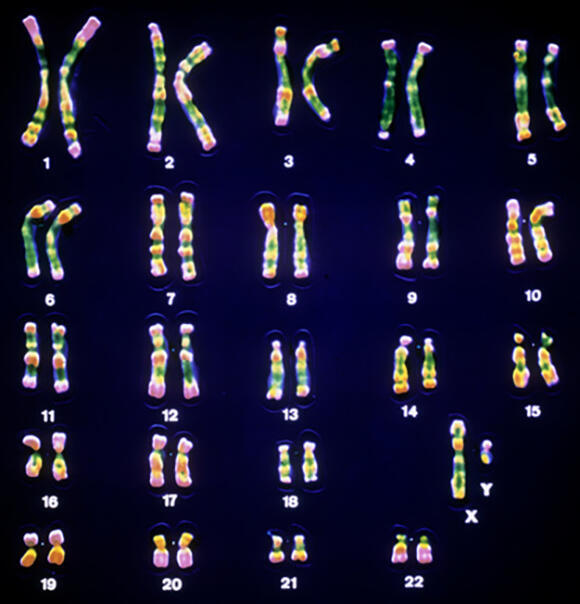Getting your Trinity Audio player ready...
When someone says 'cats', our minds typically conjure images of their cuteness, fur and playful nature, or we may recall amusing viral cat videos that made us laugh. However, we seldom associate cats with lessons in genetics. Surprisingly, cats, or more precisely, female cats, can teach us an important lesson about a genetic phenomenon that also occurs in humans, known as X chromosome inactivation.
Other stories:
Regarding boys and girls
Chromosomes serve as the structures that house our genetic material, DNA, packaged within the cell nucleus. Human DNA is divided into 23 pairs of chromosomes. Each of those pairs consists of one chromosome inherited from our mother and one chromosome inherited from our father. In other words, each of us inherits 23 chromosomes from our mother and 23 chromosomes from our father, resulting in a total of 46 chromosomes in most of our cell’s nuclei.
3 View gallery


In all mammals, females have a pair of X chromosomes, while males possess one X chromosome and one Y chromosome. Microscopic image of a male’s chromosome pairs, with the sex chromosomes positioned at the bottom right
(Photo: CNRI, Science Photo Library)
Out of the 23 pairs of chromosomes in humans, 22 pairs consist of two chromosomes that are similar in size and contain similar types of genes, both in males (boys and men) and in females (girls and women). The remaining is referred to as the sex chromosomes. In all mammals, females possess two similar sex chromosomes, called X chromosomes. In contrast, males have only one X chromosome, and a much shorter chromosome called the Y chromosome. In rare cases, individuals can be born with other chromosome combinations, such as XXY, XYY, or only a single X without a Y chromosome.
The Silent X
Having two X chromosomes is not essential to living a normal life, as evident from the composition of sex chromosomes. In fact, the presence of an additional X chromosome in females can create problematic situations. The X chromosome contains numerous genes associated with the immune system, and having two X chromosomes increases the susceptibility of women to develop autoimmune diseases such as lupus.
Therefore, a mechanism is necessary to balance the expression of genes originating from the X chromosome. Such a mechanism needs to ensure that the total amount of proteins produced according to the instructions encoded in those genes, remains consistent in both males and females. To achieve this balance, females have a mechanism that allows only one X chromosome’s genes to be active and produce proteins.
In 1961, researcher Mary Lyon proposed the existence of a mechanism that randomly silences one of the X chromosomes in the cells of females. This mechanism prevents the genes on the silenced X chromosome from producing proteins, effectively addressing the issue of producing a consistent amount of proteins. Subsequent studies conducted over the years have provided growing evidence for the existence of this mechanism. Today, it is known as X chromosome inactivation or Lyonization, named after Mary Lyon in recognition of her contribution.
Now, let's delve into how this mechanism works.
3 View gallery


In calico cats, one of the genes for fur color is silenced in each cell, while the other color is expressed. A calico cat showcases its colo
(Photo: Shutterstock)
For reasons not yet fully understood by biologists, one of the two X chromosomes in each cell of the female body begins to randomly produce RNA molecules called Xist. This process occurs at a very early stage of embryonic development in female placental mammals, including elephants, wolves, humans and cats. The Xist RNA then proceeds to wrap around and envelope the chromosome from which it originates, ultimately covering most of the chromosome’s surface.
Once Xist accumulates, the chromosome undergoes structural modifications that prevent the genes within it from being expressed and producing proteins. Moreover, proteins are recruited to the chromosome, serving as an additional barrier to gene expression. The chromosome that is silenced in this specific manner within a specific cell remains silent throughout the cell's lifespan. This process implies that each cell produces proteins solely based on genes from one X chromosome – either inherited from the father or the mother, but not both. If the genes on the father's X chromosome differ from those on the mother's X chromosome, each cell will produce slightly different proteins, potentially resulting in distinct traits. This phenomenon, in which distinct cells within an organism generate proteins based on different segments of the same genetic code or possess a different genetic code altogether (which can occasionally occur due to various factors), is referred to as cellular mosaicism.
Multicolored cats and X chromosome inactivation
So let’s revisit the topic of cats. If you happen to come across a cat with patches of ginger, black and white fur, it’s likely that you are witnessing X chromosome inactivation in a female cat. These cats are commonly known as calico cats. The reason behind their colorful appearance is that the gene responsible for fur pigment (color) is situated on the X chromosome. Two different genes for fur color exist in the X chromosomes of these cats: black and ginger. In specific cells, one of the X chromosomes is silenced, while in other cells, the other chromosome is silenced.
3 View gallery


If you come across a cat with patches of ginger, black and white fur, it’s likely that you are witnessing X chromosome inactivation
(Photo: Taliya Levav)
As a result, patches of fur in both colors emerge. The variations in the size of the white fur, which lacks pigment altogether, can be attributed to a mutation in a gene that is not located on the X chromosome. Cats without this mutation display only ginger and black fur, and are commonly referred to as tortoiseshell cats, or "torties."
But why did we mention that "almost" every cat with three colors is female? That’s because there are rare cases where males also possess two X chromosomes alongside one Y chromosome. In these rare instances, one of the X chromosomes is randomly silenced in each cell, allowing them to exhibit calico-like coloring. However, the likelihood of a calico cat being male is estimated to be less than one in a thousand.
The same phenomenon of cellular mosaicism occurs in the bodies of women, where the activity of the X chromosome is silenced. However, unlike in cats, humans don’t possess a visible trait whose gene is located on the X chromosome, so this mosaicism doesn’t manifest externally.
So, the next time you come across a cat with colorful patches on its fur, you can both appreciate its beauty and reflect on the fascinating genetic phenomenon you’ve witnessed, which reminds us that every living creature has something to teach us about ourselves.

